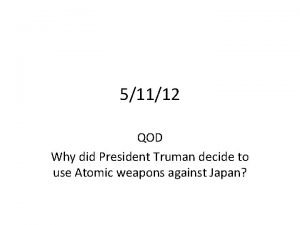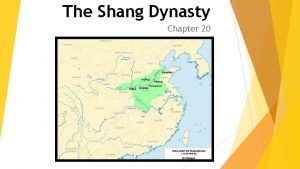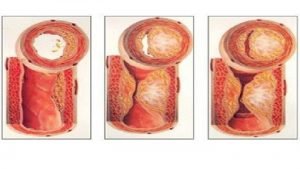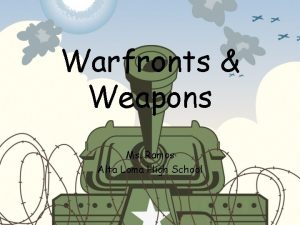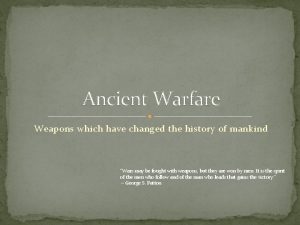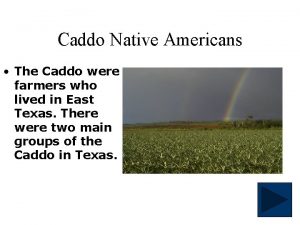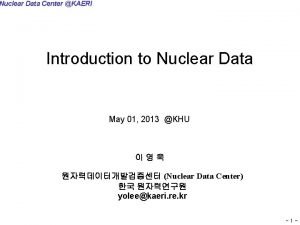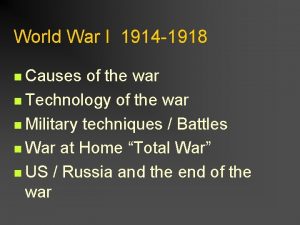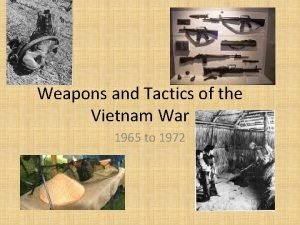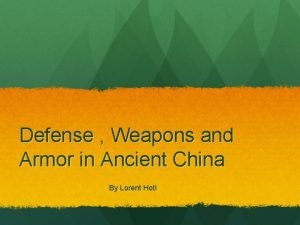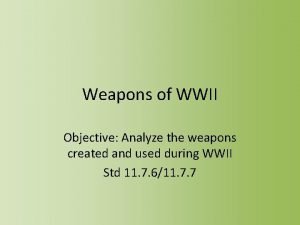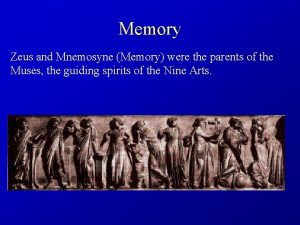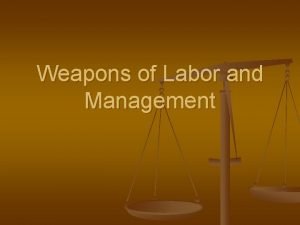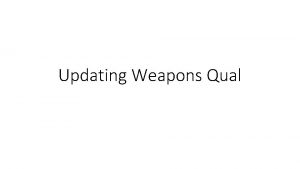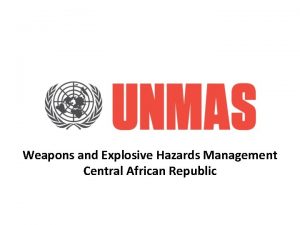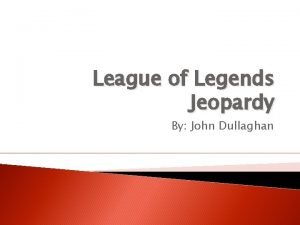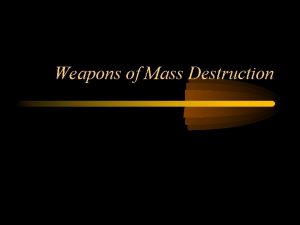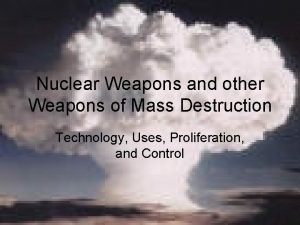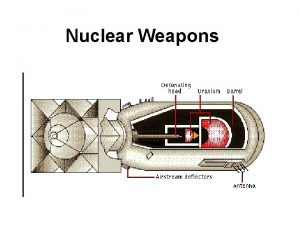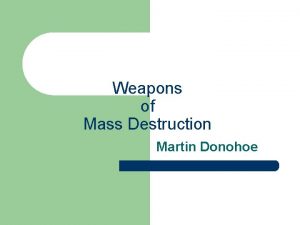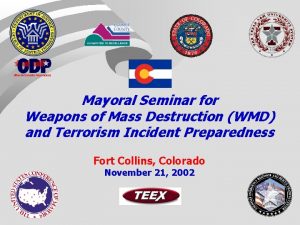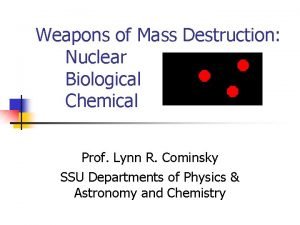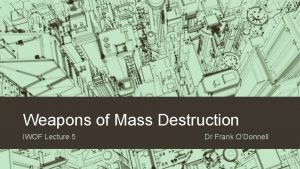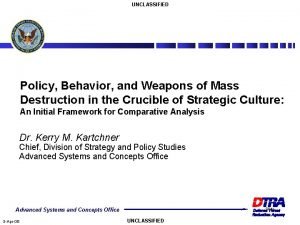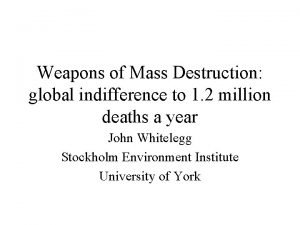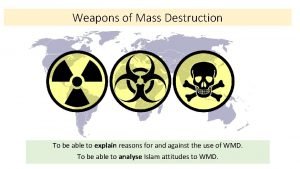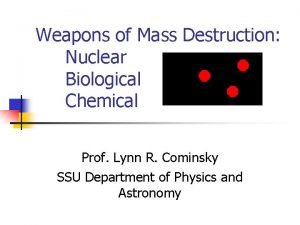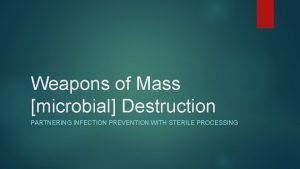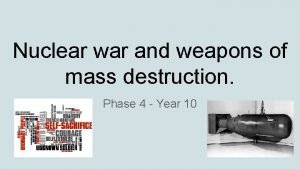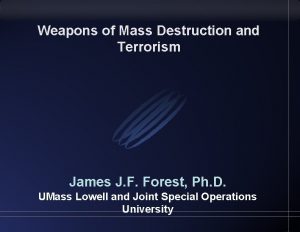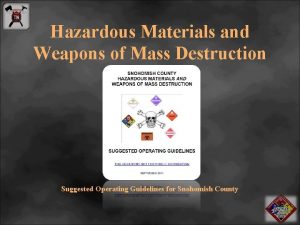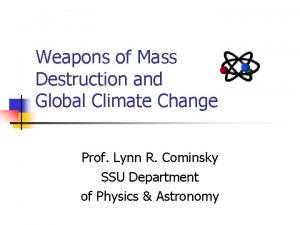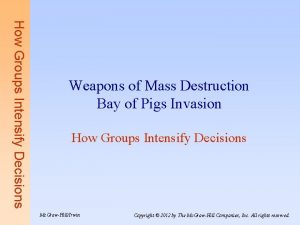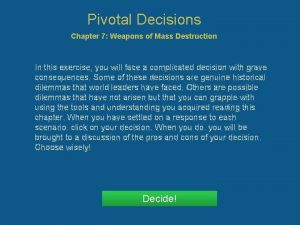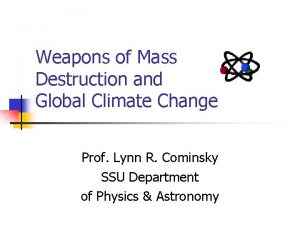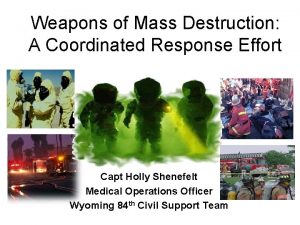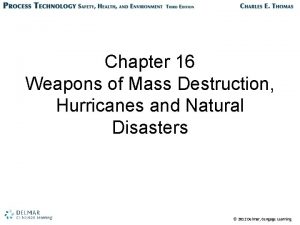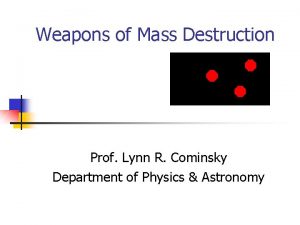WEAPONS OF MASS DESTRUCTION Weapons of mass destruction






























- Slides: 30

WEAPONS OF MASS DESTRUCTION

Weapons of mass destruction A weapon of mass destruction is a weapon that can kill and bring significant harm to a large number of humans and or cause great damage to man-made structures, natural structures or the biosphere in general.

Radiological weapons Nuclear weapons Chemical weapons Biological weapons


Radiological Weapons • The main radiological weapon is the ‘Dirty Bomb’ • Is a non-nuclear bomb with radioactive material included with the explosive • The explosion of this bomb isn’t nuclear, however the effects on people and property are very similar. • The main effects are radiation sickness, which usually leads to death. • These bombs are thought to be the first choice of many terrorists, as they are relatively easy to acquire components and construct, compared to nuclear bombs.

The Atomic Bomb • In 1942 the atomic bomb was developed in the USA to combat the threat of opponents in WWII. • After the Germans surrendered, research continued in secret. • It cost nearly $2 billion and more than 120, 000 people were involved. • It was named the ‘Manhattan Project’. • On the 16 th July 1945 the worlds first atomic bomb test was carried out in New Mexico.

Japan & The Atomic Bomb • The first Atomic Bomb was dropped on Hiroshima, Japan on the 6 th August 1945. • It was dropped from the ‘Enola Gay’ and was nicknamed ‘Little Boy. ’ • The strong winds from the blast destroyed all buildings within a 1. 5 mile radius and the huge amount of heat emitted burnt everything in its path – including the people of Hiroshima. • It is estimated that between 140, 000 and 200, 000 people have died as a result of the bomb. • Three days later the second bomb was dropped on Nagasaki, Japan. • It’s nickname was ‘Fat Man. ’ • Even though the bomb was larger and more powerful than ‘Little Boy’ it caused less damage due to the geography of the city. • Approximately 70, 000 died as a result of the bomb.

‘Little Boy’ ‘Fat Man’

The Effects Of Nuclear Weapons • Nuclear weapons produce devastating and long-term effects on human and animal life, as well as the environments in which they live. These are the hardest of all types of weapons to make because the critical nuclear elements — plutonium and/or highly enriched uranium — are hard to come by, and are very expensive. Delivery Systems • These weapons are most likely to be delivered in the form of ballistic missiles or bombs dropped by flyover bombers. Terrorists could also cause accidents involving nuclear power plants, nuclear medicine machines in hospitals and vehicles used in the transportation of nuclear waste. • The size of an actual nuclear weapon can be quite small, and could easily fit into a large car or truck. That has sparked a fear among many experts that a nuclear warhead could simply be driven into a large city by terrorists and detonated by either a suicide bomber or by remote control.

Who Has Them? • The United States has a stockpile of 10, 600 nuclear weapons and 103 power plants. Russia has a similar supply. The United Nation's ‘International Atomic Energy Agency’ oversees 900 of the world's nuclear facilities. Pakistan and India have both exploded nuclear devices in test blasts. Israel and North Korea are two countries believed to possess nuclear weapons. • Nuclear weapons continue to be a proliferation concern, particularly when North Korea recently announced it was continuing its nuclear arms program, and withdrew from the ‘International Nuclear Non-proliferation Treaty. ‘ • One worry of the United States is not so much that North Korea itself will use what weapons it has, but that it will have no qualms about selling them to the highest bidder, whether that bidder be a nation such as Iraq, which sponsors terrorism, or individual terrorist groups such as Al-Qaeda.


First comes the explosion…









…then comes the aftermath…

Biological Weapons

Biological warfare has been part of human conflict throughout the ages. Biological agents were used in many of the conflicts of the 20 th century and their use is now reported daily in the headlines. Crude methods such as using dead or diseased animals to foul wells or gifts of contaminated blankets and clothes have been replaced by delivery systems of missiles, airplanes, and the postal service. Biological agents are gaining status as a terrorist's weapon of choice The psychological and demoralizing impact of an infectious or toxic agent is likely to be more devastating than its physiological effect. Many biological agents, including bacteria, viruses, and toxins, can be used as weapons.

Biological Weapons Some of the most dangerous types of biological weapons anthrax and smallpox and fall into category A are Category B are less dangerous and cause minor fatality e. g. Q fever or enterotoxin B Category C could in the future be very dangerous such as yellow fever Symptoms vary between each category but each has flu symptoms. They are treated using antibiotics and vaccines. Anthrax There are three types of anthrax: skin, lungs and digestive. It was used as a weapon in 2001 across America with 22 reported cases of anthrax infection Anthrax is a category A weapon because it poses the greatest possible threat for a bad effect on public health, may spread across a large area or needs public awareness and planning to protect the public’s health

Chemical Weapons

CHEMICAL WEAPONS OF MASS DESTRUCTION Chemical weapons did not become true weapons of mass destruction (WMD) until they were introduced in their modern form in World War I (1914– 18). The German army initiated modern chemical warfare by launching a chlorine attack at Ypres, Belgium, on April 22, 1915, killing 5, 000 French and Algerian troops and momentarily breaching their lines of defense. German use of gas and mustard was soon countered by similar tactics from the Allies. By war’s end, both sides had used massive quantities of chemical weapons, causing an estimated 1, 300, 000 casualties, including 91, 000 fatalities. The Russian army suffered about 500, 000 of these casualties, and the British had 180, 000 wounded or killed by chemical arms. Onethird of all U. S. casualties in World War I were from mustard and other chemical gases, roughly the ratio for all participants combined. By the war’s end, all the great powers involved had developed not only offensive chemical arms but also crude gas masks and protective over-garments to defend themselves against chemical weapon attacks. Altogether, the warring states employed more than two dozen different chemical agents during World War I, including mustard gas, which caused perhaps as many as 90 percent of all chemical casualties from that conflict.

Chemical Weapons • Chemical weapons are mainly gas based weapons and the use of them were banned in 1925. • The first chemical weapon to be used was ‘Mustard Gas’ in WWI. It caused massive bleeding and took a person about 5 weeks to die of poisoning. It is estimated to have affected 1 million soldiers and killed 40, 000. • The most dangerous chemical weapon known is ‘VX’ and attacks the nervous system. • VX was created in the UK who then traded it the USA for their nuclear weapons programme • The main effects of VX are spasms, comas and eventually death • Only America, Russia and France are known to have VX, and it is unlikely ever to be used as a counter attack of nuclear weapons would be likely


Since 1940 the USA has spent $239182430 every day on defence of their country That works out at approximately $9 million an hour Or $166 thousand a minute …they have 10, 600 nuclear weapons at their disposal…

 Axis powers
Axis powers Shang empire
Shang empire Three sisters bows
Three sisters bows The weapons we fight with
The weapons we fight with Kitchen equipment scavenger hunt answers
Kitchen equipment scavenger hunt answers Warfront weapons
Warfront weapons Ancient warfare weapons
Ancient warfare weapons Egyptian gods weapons
Egyptian gods weapons Caddo tools and weapons
Caddo tools and weapons Mesopotamia weapons
Mesopotamia weapons N233pa
N233pa Algonquin tools and weapons
Algonquin tools and weapons Weapons of wwi
Weapons of wwi Mayan weapons
Mayan weapons Us weapons vietnam war
Us weapons vietnam war State bords
State bords Abrir usted command
Abrir usted command Ancient china weapons
Ancient china weapons Weapons
Weapons Ephesians weapons of warfare
Ephesians weapons of warfare Parents de mnemosyne
Parents de mnemosyne Weapons
Weapons Std atomic load
Std atomic load Vin diesel has ten weapons
Vin diesel has ten weapons M4 weapons qual card
M4 weapons qual card Weapons معنى
Weapons معنى Weapons
Weapons 5 affirmative commands in spanish
5 affirmative commands in spanish Metal age in india
Metal age in india Weapons of righteousness
Weapons of righteousness League of legends jeopardy
League of legends jeopardy
